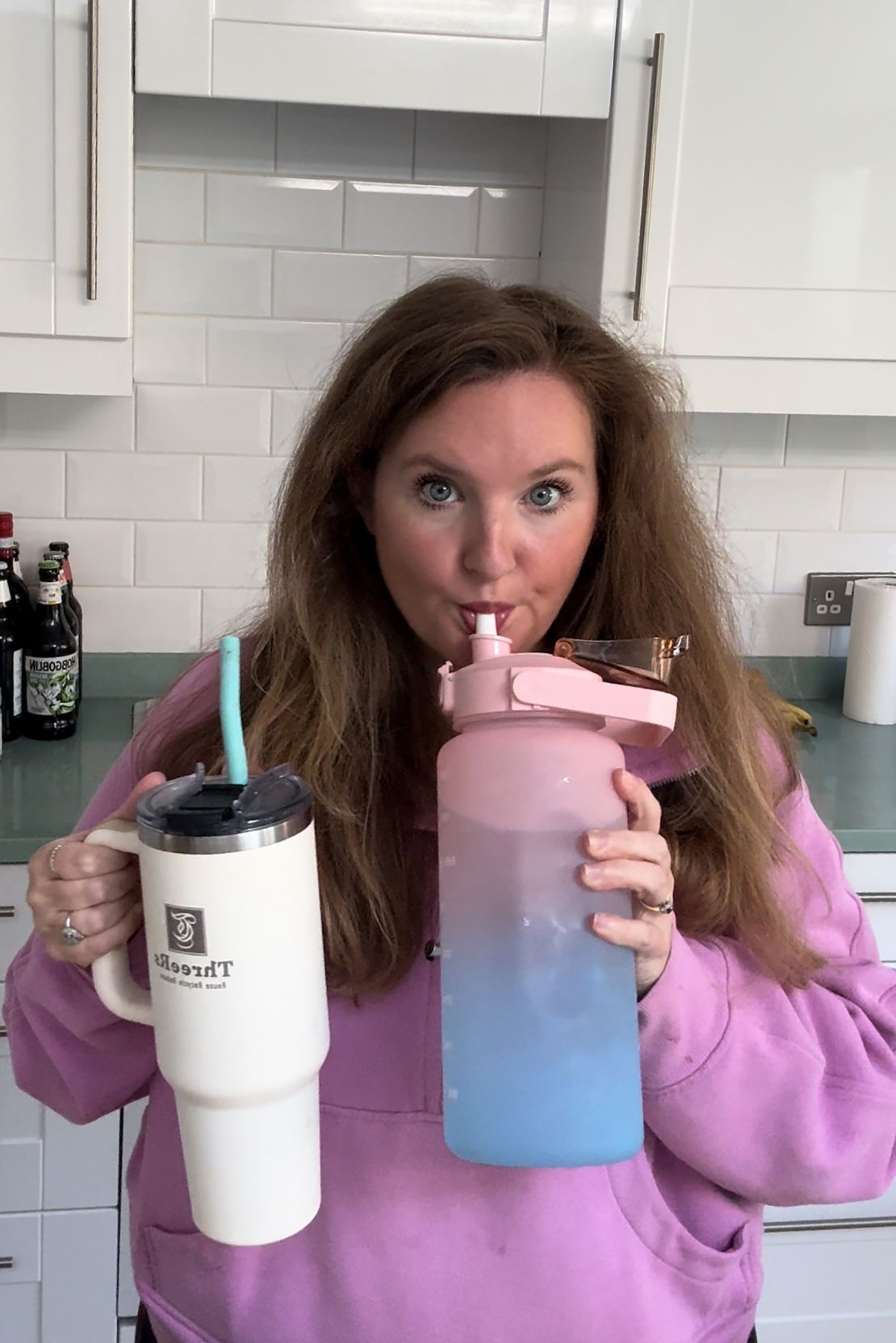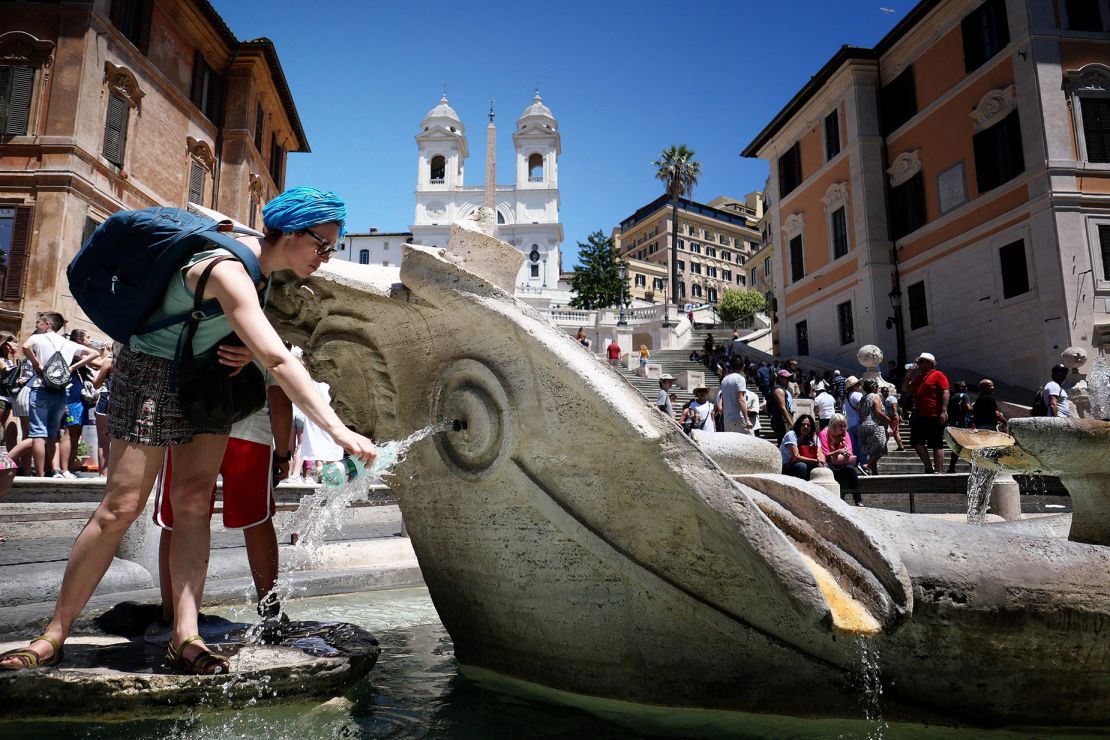Americans on TikTok are outraged about European tap water. Here’s what’s really going on

American Helene Sula vividly remembers the first time she discovered tap water was a different ball game in Europe.
Sula, from Texas, was at a restaurant in Germany. When the server asked for her drink order, Sula requested water.
“They kind of scoffed at me like, ‘You can get water. But why would you?’” Sula recalls.
She remembers glancing around and realizing everyone else in the restaurant was enjoying glasses of wine and pints of beer – no water to be seen.
Sula repeated her water order and the server demurred. But, when the water arrived, it wasn’t the giant glass of free tap water, sloshing with ice, Sula was expecting.
Instead, she was served a single glass liter bottle of sparkling water, accompanied by a tiny drinking glass and 2 Euro price tag.
“In the US, you sit down at the table and you’re given a huge glass of water with ice and it’s not even a question – it’s just plopped on the table. No matter if you’re at a fancy restaurant or a casual restaurant, you’re going to get a huge free glass of water,” Sula tells CNN Travel.
A few years later, when Sula and her husband relocated to Germany – the couple observed another water-related cultural difference.
Whenever they went out hiking, biking or walking the city, Sula and her husband would pack large water bottles – sometimes even CamelBaks, a type of water backpack (“So we can drink water at every possible moment,” Sula explains).
Meanwhile their European friends often went without water entirely, holding out until they decamped to a bar that evening – and even then, they’d usually opt for wine instead. Sula couldn’t believe it.
“I just figured, maybe Europeans just don’t get as dehydrated as we do,” says Sula, still audibly baffled after several years living in Europe.
Understanding European water habits

If you’re thinking: “Wait, this is just one person’s opinion and it’s a pretty broad generalization,” you’d be right. After all, there are many different countries within Europe, each with their own culture, dietary habits, traditions and water-drinking habits.
And of course the US isn’t a cultural monolith either. Sure, some Americans take pride in their enormous Stanley cups and undertake water-related daily challenges, but others would always opt for soda if given the choice.
And while many Americans are conscious of the environmental impact of plastic water bottles, others actively eschew water from the kitchen faucet and keep their fridge stocked with bottled water.
Nevertheless, Sula isn’t alone in her observations. US travelers sharing hot takes on European tap water consumption (or lack thereof) has become a bit of a social media trend over the past year or so.
Take TikTok user br3nnak3ough, who in summer 2023 uploaded a video depicting her friends downing large bottles of water, overlaid with the text: “Us the moment we can find water because Europeans don’t believe in water.”
This video been viewed 10.9 million times and attracted 13,800 comments – both from Americans in agreement (“I was so dehydrated when I went lol, the heat + lack of ac and water/ice had me dying..”) and Europeans vehemently disagreeing (“What are you talking about”)
Meanwhile, Rob Murgatroyd, an American living in Italy, recently uploaded a TikTok commenting that the difference between US and Italian water consumption had “blown his mind” since moving to Florence.
“Where I come from, we’re practically wired to drink water non-stop, as if it’s our main gig, while here in Italy, spotting someone with a water bottle is like finding a needle in a haystack,” Murgatroyd captioned the video.
There are TikToks marveling at the size of European water glasses, Instagram Reels chronicling the often ill-fated quest to order a jug of tap water in a European bar and posts on X bemoaning paying for bottled water in restaurants.
Sula, who chronicles her life abroad on the blog Helene in Between, has weighed in on the great European tap water debate a couple of times – including at the end of last year:
“Tap water is not free at (European) restaurants,” Sula asserted in a November 2023 TikTok video. “And if you do get it, it comes in a miniscule glass.”
Plenty of commentators were dismissive: “It’s free. They’ve seen you coming from a mile off,” read one response.
Others echoed Sula’s experience, adding that while tap water is usually available – bottled mineral water or bottled filtered water is more commonplace in many European countries.
“I think it’s a really interesting conversation,” says Sula. “The world can feel very small sometimes, because we’re all online and it’s such a global society now … so I think it’s interesting to have these conversations, to talk about the differences.”
A water expert weighs in

To get a sense of what’s really going on beyond just the anecdotal evidence, CNN Travel called up Stavros A. Kavouras, a professor of nutrition at Arizona State University. Kavouras is director of the university’s Hydration Science Lab, which focuses on the impact of hydration on health and performance.
Kavouras is also a Greek expat who’s lived in the US for 20 years, so he’s pretty well placed to comment on transatlantic culture clashes.
First off, Kavouras emphasizes the myriad of differences between the countries that comprise the European continent. He highlights, for example, the contrast between “Northern European foods versus French, Italian, Greek cuisine, and dietary preferences.”
“I don’t like the generalizations,” says Kavouras, who says while it’s tempting to set up a Europe versus the US dichotomy, it doesn’t usually stand up.
Kavouras also points out that Americans who visit Europe (and post about it online) don’t represent the majority of the US population.
“It’s not the average American,” says Kavouras. “The skewed population that you see coming to Europe – they are people that are more educated, wealthier, higher socioeconomic status…”
This is relevant, states Kavouras, because there’s data to suggest Americans of lower socioeconomic status drink less water.
But after laying down these parameters and qualifications, Kavouras agrees there are some potential differences between the US and Europe when it comes to “what people drink, what people like, and how hydrated they are.”
“For instance, if you go to Germany and you ask for water, you get sparkling water. That’s the default,” Kavouras says. “And so if you served tap water in Germany, to every human, people would be like, ‘Oh, I don’t drink this water.’ So why would you do it?”

Kavouras also notes that paying a few euros extra for a liter glass bottle of water at dinner is more accepted in Europe than the US. While Americans might be shocked, it’s something many Europeans wouldn’t think twice about, says Kavouras.
He suggests Americans perturbed by the extra cost could look at it as “the equivalent of the American tip that you have to pay guaranteed 17 to 25% nowadays in the United States.” (Tipping culture in Europe is quite different – and usually involves much smaller percentages)
As for whether Europeans are generally more dehydrated than Americans, Kavouras says it’s interesting that there’s a difference between the dietary guidelines for water intake in the US and Europe.
“In the United States, the guidelines are 2.7 liters for females, and 3.7 liters per day for men. And in Europe, the equivalent numbers are 2.0 and 2.5,” he says. “So these are the guidelines – it doesn’t mean this is what people drink – but this is what is recommended.”
And as for the American TikTokers joking about tap water served in tiny “shot glasses” in Europe, Kavouras suggests this could be part of a more general difference between the US and the rest of the world.
“I mean, you know the stereotype – the US does it bigger for everything – cars, houses, everything is bigger, servings in restaurants…etc. I think it might be a little bit of that,” says Kavouras – adding the same applies for the “the water carry containers that Americans carry around.”
Kavouras always finds it amusing when he spots his colleagues coming into work with “a tiny barrel of water, like there’s no water in the building.”
Giant water containers are “unnecessary” in Kavouras’ opinion. That said, Kavouras advises everyone should find a way to ensure they’re well-hydrated throughout the day – whether they’re working in an American office or walking around a European city.
“Water is a critical component of every healthy diet. So being adequately hydrated, it’s very important, especially in the summer,” he says.
Advice for Americans

If you’re an American traveler heading to Europe this summer and panicking about the water situation, Kavouras advice is to, first off, take all the viral social media posts with a pinch of salt.
It’s worth researching the specific destination you’re heading to, and finding out what’s the norm there – rather than assuming every country in Europe is the same. Familiarize yourself with the words used for sparkling, still and tap water in your destination’s language, so you can make sure to order your preference.
And if you want to skip bottled water at restaurants, Kavouras suggests staying hydrated by stocking up at a grocery store instead: “Bottled water is not as expensive if you plan a little bit and buy the water from the supermarket, versus buying it always in restaurants.”
And Kavouras’ final piece of advice? Pack a reusable water bottle in your suitcase and carry it with you throughout your vacation – not only on your travel days.
“Tap water in most European cities is potable, it’s safe, and you can drink it,” Kavouras says.
Many European cities have fountains across the city where people can stop and hydrate. Hotels, cafes and restaurants will usually fill up your bottle for you if you ask.
“Bring an empty water bottle – it really doesn’t have to be a gallon,” says Kavouras. “Just bring a normal size water bottle so you can refill it whenever you have a chance.”
Source: https://edition.cnn.com/travel/tiktok-tap-water-europe-trend/index.html





